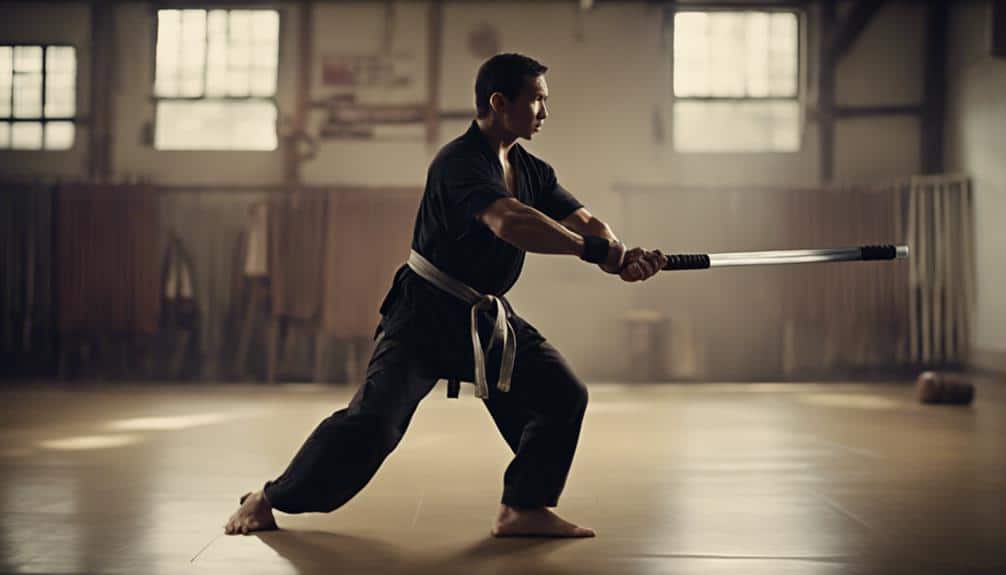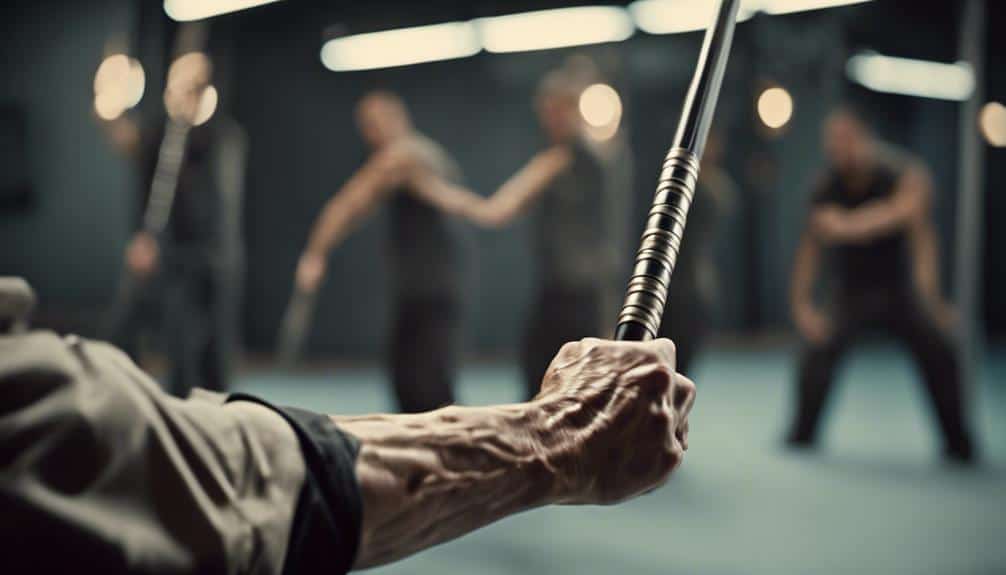
free shipping on orders over $25
We’re having a sale on all our products. Enter your email below to be notified about future sales.

Alright, so you’re excited to get the hang of a telescopic baton for self-defense, huh? First, learn to snap open your baton with confidence; a solid ‘whack’ sound ensures it’s prepared. Carry it in your back pocket for easy access – quick draw, ninja style! Strike smartly: try downward strikes for impact, upward jabs for surprise, and side swings to keep foes at bay. Remember, aim for major muscles or limbs, not crucial spots. And practice, folks might try to snatch it! Work on escape moves to maintain control. Stick around, there’s a lot more to these dynamic techniques.

When comparing similar weapons, the expandable baton stands out for its compactness and lightweight design. You’ll notice that unlike a bulky billy club or a nightstick that feels like swinging a log, the expandable baton is surprisingly easy to carry. It doesn’t weigh you down, so you can move quickly and stay agile.
Now, envision this: you’re in a self-defense situation. The expandable baton may look small, but it packs a punch. With proper training, you can release a strong, controlled impact. It’s like having a secret weapon in your pocket, ready to spring into action when you need it most. Imagine the confidence boost knowing you’ve got this effective tool at your side.
Police officers often opt for larger, heavier expandable batons to maximize impact, but for everyday use, the lighter version is just as effective. You won’t break a sweat carrying it around. And trust me, once you get the hang of it, you’ll feel like a pro. Remember, training and technique are key. Without them, it’s just a fancy stick.
Given its compact and lightweight design, the telescopic baton offers multiple versatile carry options that make it an ideal tool for everyday self-defense. You can easily slip it into your back pocket, making it both accessible and discreet. Imagine walking down the street, feeling confident because you know you have a reliable self-defense tool at your fingertips.
You can also tuck it inside your waistline, hidden under an untucked shirt. This is perfect for those days when you want to keep it out of sight but still within quick reach. The baton’s small size doesn’t just make it easy to carry—it also allows you to deploy it swiftly with either hand, adding flexibility when you need it most.
Think about the convenience of carrying it in various pockets; whether it’s your jacket, pants, or even a small bag, the baton fits right in. You won’t feel weighed down or uncomfortable—it’s like having a secret weapon that’s ready to go whenever you are.

Understanding lethal force considerations is necessary when training with a telescopic baton for self-defense. It’s vital to remember that while a telescopic baton offers significant stopping power, it’s still an intermediate-level force tool. You’re not wielding a lightsaber here, but it can still cause serious harm if used improperly.
When you’re in a tense situation, your adrenaline might push you to use maximum force. However, targeting the head or throat can lead to lethal injuries. Instead, aim for non-lethal areas like major muscle groups, hands, and legs. This approach helps you create distance from your attacker without causing permanent damage. Think of it as a way to buy yourself time to escape rather than turning into a martial arts movie hero.
Proper training focuses on using the baton effectively while avoiding necessary force. Instructors will drill into your head the importance of control and precision. They’ll remind you that your goal is to stop the threat, not to escalate the situation.
To utilize the expandable baton effectively, snap it open with a quick, decisive motion. You’ve got to do this confidently—no hesitation. Imagine you’re in a tight spot, and you need that baton ready to go. The snappy movement ensures it’s fully extended and prepared for action.
Once it’s open, make sure you have enough space around you. Expandable batons are versatile tools, but they require room to work. In narrow spaces, you might find it challenging to swing without hitting obstacles—or worse, missing your target. So, create a bit of a buffer zone if you can.
Now, let’s discuss strikes. You’ve got options: downward strikes, upward jabs, side swings. Each movement has its own purpose, and mastering them makes you more adaptable in different scenarios. Watch training videos for a visual guide—they’re incredibly helpful for observing the techniques in action.

Holding onto your baton firmly secures it from being snatched away during a confrontation. Retention is key when using a telescopic baton for self-defense. Envision you’re in a tense situation, adrenaline pumping, and suddenly, your attacker lunges for your baton. Scary, right? That’s why learning how to retain your baton is essential.
Expandable batons are designed to help with retention. They extend quickly, giving you that critical edge. But it’s not just about the design; it’s about mastering the techniques. Picture the scenario: you’re gripping your baton, ready for anything. An attacker tries to grab it, but you’ve practiced your defensive escape maneuvers. You twist, step back, and maintain control. Boom! You’ve kept your weapon and your confidence.
Always think about retention. When you train, visualize scenarios where someone tries to disarm you. Practice those escape maneuvers until they’re second nature. It’s like learning a dance, but with more intensity and purpose.
Yes, a telescopic baton is great for self-defense. You can leverage its concealability, reach, and defensive techniques to handle threats effectively. Whether you’re a beginner or experienced, it offers versatile and practical solutions in critical situations.
You need to be aware of state laws regarding collapsible batons. They’re illegal for civilians in California, Massachusetts, New York, and Washington D.C. Always check specific state regulations before carrying one to avoid legal issues.
Yes, you can defend yourself with a baton if you’ve mastered the training techniques. Proper training enhances your ability to target specific areas effectively, ensuring your self-defense actions are both efficient and legally compliant.
The ideal length for a self-defense baton is between 16 to 26 inches. You’ll want to balance reach and maneuverability, considering your personal preference, skill level, and local legal restrictions. Experiment to find what fits you best.